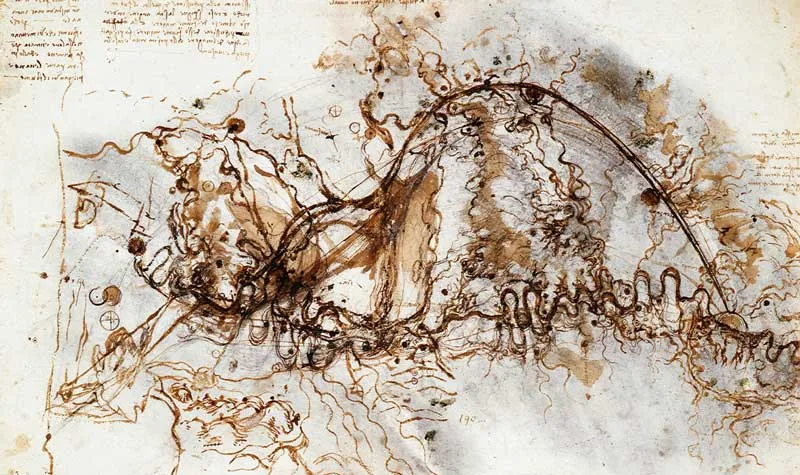
It might surprise you that Leonardo da Vinci (1452–1519) was obsessed with plumbing. You surely know the “Renaissance Man” who designed flying machines, but did you know that the singular constant in his study of nature, art, and engineering was his fascination with water? While Leonardo holds perennial appeal in the global imagination, 2019 marks the 500th anniversary of his death, an occasion stimulating further inquiry into his curious mind. Indeed, the artist provides compelling ways to think about stewardship of the environment today.
Leonardo’s writings summon the element of water like Moses’ staff striking rock.
My forthcoming book, Watermarks: Leonardo da Vinci and the Mastery of Nature (Princeton University Press, 2020) analyzes the artist’s lifelong study of water. For Leonardo, the world needed describing, and complex patterns of water movement posed the greatest difficulty. Again and again he described water flow, mapped rivers, and, of course, painted flowing streams—looking at the background of the Mona Lisa, you’ll see both snow-capped mountains and dried up riverbeds. He wrote lengthy descriptions of tides, storms, and river currents. In fact, Leonardo wanted to write a treatise dedicated to water, and while that book was never written, we have an extensive understanding of his attempts to explain hydrological phenomena in staggering, encyclopedic detail.
Leonardo’s writings summon the element of water like Moses’ staff striking rock. At the touch of his quill, the sound of water inundates his notebooks, gurgling and rushing along rocky plains, resounding through the canyons he imagines. Leonardo’s water machine drawings establish a modus operandi for his pictorial thinking, and the motions of his mind course through these drawings. Water bears witness to his extraordinary curiosity and formidable creative powers of problem solving; it returns incessantly to activate works ranging from doodles to the primordial landscapes of his paintings.
The brilliance of his inquiry into the essence of water is his awareness that nature itself is in a constant state of flux. Leonardo and his contemporaries negotiated this fundamental instability by studying and devising means to address environmental changes. For the engines of industry to turn and for health and safety to be preserved, canals had to be dredged, water pumped, weirs built, crops irrigated, and seasonal floodwaters contained. Renaissance engineers knew keenly the necessity of water management, as did those whose lives and livelihoods depended upon the anticipation of and effective responses to the unruly movement of water.
Watermarks seeks to contribute to the promising new directions posed by interdisciplinary research within the environmental humanities. The cultural study of water pertains to man’s relationship to nature at a time of great urgency. I completed this project while living in New Orleans, a city whose flood protections are all but guaranteed to once again fail with catastrophic impact unless drastic, astonishingly expensive and extensive preventative measures are undertaken, as my colleague in the Department of History, Andy Horowitz, describes in his recent article “When the Levees Break Again” for The New York Times. The tasks of calculating when—not if, as the 100-year or 400-year projections make clear—such a disaster may occur are about more than probability assessments of the efficacy of prevention and containment. To gauge the likelihood of such an event and its cost estimation seems a feat of absurd proportion, and this is not even to consider the incalculable loss of life, communities, industries, and national injury to our ideals of a shared commons. Yet such a task would have spurred Leonardo’s thought. He would not have been solely consumed with the scope of rising sea levels and hurricane flooding, or even the engineering of frail infrastructure. In every endeavor he combined observation and idealization, the analytic and the poetic. To view scientific and aesthetic modes of investigation as disparate would not have occurred to him. In this regard, he offers a model of how to go about confronting perilous environmental challenges facing communities throughout the world. The problem of water lies in our collective future as much as our past, and solving it will necessitate marshalling all forms of creative and scientific endeavor.
Leonardo and his peers prove that our understanding of nature is culturally embedded. In seeking to understand more fully that which escapes ready comprehension—such as the fundamental intertwinement of man with all things in nature—we might see more clearly. With wisdom we might expand our field of vision to perceive beyond the limits of what we know to what might be.
This essay has been adapted from Leslie Geddes’s forthcoming book, Watermarks: Leonardo da Vinci and the Mastery of Nature (Princeton University Press, 2020).


